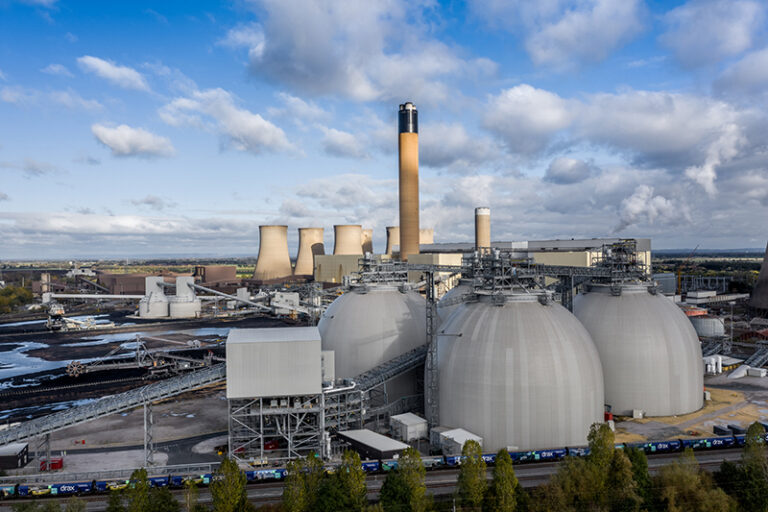A £22bn question: aligning UK CCS policy with essential progress on emissions and energy resilience

The Government has confirmed up to £22bn of funding over 25 years to enable the UK’s first carbon capture and storage (CCS) projects. This is a welcome step but more nuance is needed in CCS policy to drive a long-term project pipeline that fully aligns with net zero and energy resilience objectives, argue Esin Serin and Emily Bradeen.
Rapid scale-up of CCS is needed
When the Climate Change Committee (CCC) first recommended a net zero target for the UK in 2019, it concluded that carbon capture and storage (CCS) was a ‘necessity, not an option’. In 2021, the Conservative government published the UK’s first Net Zero Strategy, which set a target for the country to deploy enough CCS capacity by 2030 to capture and store 20 to 30 million tonnes of CO2 (MtCO2) per year. This target was broadly in line with the CCC’s balanced net zero pathway.
The Department for Energy Security and Net Zero, and before that the Department for Business, Energy and Industrial Strategy, have progressed a set of programmes and frameworks in recent years to drive deployment, guided by that target. The recently elected Labour government has yet to specify the extent to which it intends to rely on CCS in reaching net zero, but this is likely to be substantial. Even the scenario with the least reliance on CCS in the CCC’s Sixth Carbon Budget sees around 13 MtCO2 being captured annually by 2030. This will require rapid scale-up of CCS in the years ahead, as the country currently has virtually no operational capacity. By 2050, the balanced net zero pathway requires an annual capture capacity of over 100 MtCO2, more than half being for CO2 removals.
CCS can support the UK economy by enabling emissions-intensive domestic industries like steel and cement to continue operating in a decarbonising world. It also presents important growth opportunities for UK supply chain companies from the global demand for related technologies and services, which is expected to grow rapidly. Influential organisations including the International Energy Agency, International Renewable Energy Agency and Intergovernmental Panel on Climate Change have all produced long-term energy outlooks that rely on a major expansion of CCS globally in order to limit global temperature rise to 1.5°C.
Investment must happen now
The UK can only tap into the opportunity afforded by CCS if it urgently invests to develop domestic capabilities – capitalising on its existing strengths in related innovation and supply chains – to serve global markets competitively. Other countries have already begun investing in their domestic CCS capabilities: the US and Europe made over US$20bn available to CCS projects in 2023 through ongoing subsidy programmes.
Indeed, this parliament might be the UK’s last chance to establish itself as a competitive player in this area. CCS policy in the UK has had a ‘turbulent’ history, with the late-stage cancellation of two major funding competitions in 2011 and 2015, damaging investor confidence. The newly elected Labour government must now act quickly and decisively to convince the private sector that it is serious about developing a strong domestic CCS industry. On 4 October it provided a strong signal by announcing almost £22bn of funding over 25 years for CCS development in two industrial clusters.
How much CCS is developed – and for what purpose – matters
£22bn might be the shiny headline figure, but without further detail it means little in the way of ensuring CCS will be used as a genuine solution to support the UK’s path to net zero. CCS can be used to clean up a variety of sources of CO2 in different sectors, including heavy industry such as cement, gas-fired power generation and hydrogen production plants. It can also enable the removal of existing CO2 from the atmosphere when coupled with biomass-fired power or when CO2 is captured directly from the air. However, over-relying on CCS in areas where it is just one of many viable methods of decarbonisation could undermine the UK’s transition towards a clean economy.
Two particular applications of CCS considered in the UK – namely in gas-fired power and hydrogen production (known as ‘blue’ hydrogen) – involve building new infrastructure that will depend on the use of natural gas. Both of these applications will likely have some role in achieving net zero. But building too much capacity for such projects too soon may lock the UK into years of avoidable gas dependence, prolonging the dangers of dependence on volatile global gas markets and leading to supply chain emissions. Given there is evidence of path dependence in system transformations, such risks would spill over beyond the project level. For example, an over-reliance on CCS could impede the development and uptake of renewable-driven electrification and green hydrogen in industry.
Policy needs to become more nuanced
We previously warned that the UK’s initial set of CCS projects invited for negotiations for support under the previous government signalled a disproportionate policy focus on blue hydrogen projects. Similar concerns have since been voiced by a number of organisations, such as the Institute for Energy Economics & Financial Analysis and the Carbon Tracker Initiative and, more recently, in an open letter from a group of academics and campaigners asking the Secretary of State to pause the UK’s policy on CCS-based hydrogen and gas power.
The new government should address these concerns by bringing more nuance to CCS policy, acknowledging that different CCS applications are not created equally. This should include specifying how much CCS it intends to rely on in which sectors as part of a new Net Zero Strategy (while leaving flexibility to adapt to technological developments on the way), and ensuring every project it decides to support is assessed holistically for its impacts on energy resilience, emissions and progress towards reaching net zero.
Using taxpayers’ money to support only those projects with credible potential to contribute to decarbonisation efforts could also help to mitigate litigation risk. Requests for judicial review have already been filed to challenge the installation of CCS technology at Drax Power Station and the development of Net Zero Teesside, a gas-fired power station with carbon capture technology (the latter is among the first set of projects that secured government support in the recent announcement). The challenges to these projects relate to the credibility and accuracy of their estimated impact on emissions. Although the final outcomes of both cases are uncertain (for latest updates, see here and here), legal challenges to projects can create costly delays and affect the public’s willingness to accept the need for CCS projects, particularly those that are publicly funded. Policymakers should ensure that CCS projects receiving government support align with the UK’s legal obligations to achieve net zero by 2050.
The longer-term view
The Government already needs to be looking beyond the first set of projects if it is to access the full extent of benefits offered by CCS. It needs to build on existing support to drive a long-term project pipeline that reflects the potential role of CCS in different sectors and different regions, focusing not just on industrial clusters but also on emitters in dispersed sites by facilitating the development of non-pipeline transport options for CO2. All of these projects will need to align – individually and collectively – with essential climate action and progress towards a secure and resilient energy system.
The authors would like to thank Josh Burke, Catherine Higham and Georgina Kyriacou for their helpful review of this commentary. A version of this commentary was first published by Business Green on 15 October.

